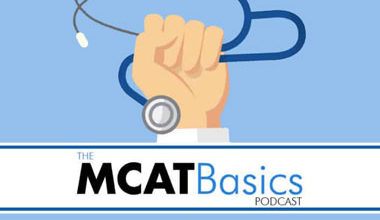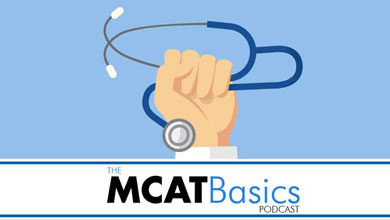Sam Smith discusses energy and work for the Chem/Phys section of the MCAT. He covers the mathematical and conceptual definitions of work, the sign convention of work, mechanical advantage and path dependency. He also covers Energy, including the general definition of energy, comparing and contrasting energy and work, the different types of energy, and heat transfer.
- [01:43] Work
- [06:28] Units of Work
- [07:18] Sign Conventions of Work
- [11:42] Work Kinetic Energy Theorem
- [15:38] Path Dependent vs Path Independent Work
- [18:29] Mechanical Advantage
- [21:08] The Efficiency of a Machine
- [23:17] Work and Power
- [24:25] Work and Energy
- [29:10] Types of Heat Transfer
What is Work?
Work is a measure of energy transfer. Also, it is a scalar value – meaning that it does not have a direction, only a magnitude. In some cases, when calculating work, you must account for the angle or direction in which the force is being applied to move an object.
Work = force × distance
For example, if you are pushing a wooden block across the floor, a force on the block that is perpendicular to the floor will not move the block at all. On the other hand, a force on the block that is parallel to the floor will move the block most effectively- this is the optimal angle at which force can be applied to move the wooden block. At this angle, all the force being applied on the block will be converted into work.
When force is applied at an angle (θ):
Work = force × distance × cos θ
When force is applied perfectly parallel to the floor, the angle between the floor and the force will be 0°:
Work = force × distance × cos (0°)
Work = force × distance × 1
Work = force × distance
When force is applied perfectly perpendicular to the floor, the angle between the floor and the force will be 90°:
Work = force × distance × cos (90°)
Work = force × distance × 0
Work = 0
Hence, you are doing no work when you are applying a force perpendicular to the floor.
The Unit Circle is an important part of dealing with these questions. For example, when tackling a question that says that force is being applied to an angle at 60°, knowledge that cos (60) = ½ is imperative.
Units of Work
F [=] Newtons (N) or pound-force (lbf)
d [=] meters (m) or feet (ft)
W [=] work measured in Newton meter (Nm) or foot pound-force (ft-lb)
A Newton meter (Nm) is equal to a joule (J), which is the unit of energy in the SI system. The units of work are the same as the units of energy.
Sign Conventions for Work
Thermodynamic Work
Work can be positive or negative. If work is done to the system, the system is gaining energy so the sign is positive. If work is done by the system, the system is losing energy so the sign is negative.
Mechanical Work
If the applied force on an object and its displacement are in the same direction, then the work is positive. If the applied force on an object and its displacement are in opposite directions, then the work is negative.
Work Kinetic Energy Theorem
Kinetic energy is the energy associated with a moving object.
Kinetic Energy = ½ × mass × velocity^2
Ek = ½ mv^2
Work causes an object to move. If an object is moving at a constant velocity, no work is done to the object.
The net work done on an object is equal to the change in that object’s kinetic energy.
If Ek (at initial) = Ek (at final point), then W= 0.
Also, the heavier an object is, the more work needs to be done to get it moving to a certain velocity.
Path Dependent vs Path Independent Work
Path dependent variables are variables in which the path between two points that an object takes matters for that variable. Friction is an example of a force that is path dependent. In the presence of friction, some kinetic energy is always transformed into thermal energy.
Path independent variables are variables in which the path between two points that an object takes does not matter. Gravitational potential energy is an example of a force that is path independent.
Work can be a path dependent and a path independent variable. It depends on what type of force is being applied to do the work.
Friction is a non-conservative force – work done against friction is path dependent. In the presence of friction, some kinetic energy is always transformed to thermal energy, so mechanical energy is not conserved. Work that is done by conservative forces (forces that don’t leak energy, like gravity), results in work that is path independent.
Mechanical advantage
Mechanical advantage is a measure of force amplification achieved by a mechanical tool or device. It is expressed as a number that is dimensionless; it does not have units. Examples are pulleys, wedges, inclined planes, wheels, axles, etc.
MA = output force / input force
Hence, if MA = 2, you are getting 2X the amount of force out of the machine than you are putting in.
If MA < 1, then you are putting more work into the machine than you are getting out.
Mechanical tools generally work by applying less force over a greater distance. For a machine or tool, the work in must be equal to the work out:
Work (into the machine) = Work (out of the machine)
∴ Force × distance (into the machine) = Force × distance (out of the machine)
A machine can work in one of 2 ways:
- An increased distance over which a force is applied
- An increased force applied over a shorter distance
Real life example: When you’re throwing a baseball, your arm is acting as a lever. What allows pitchers to throw the ball in excess of 100mph is the fact that the arm acts as a lever. The force that is exerted on a baseball when you’re throwing it is a lot more than the force that is exerted by the shoulder.
Mechanical Efficiency
The efficiency of a machine is the ratio between work the machine supplies and work that is put into the machine.
Efficiency of a machine = output work / input work
In ideal situations, efficiency will be equal to 1 (100%). In real life, however, efficiency will be less than 1; the work out will be less than the work in.
Work and Power
Power is the rate at which work is performed.
Power = work / time
∴ Power = force × distance / time
∴ Power = force × velocity
Power has units, J/s, or Watts.
Work and Energy
Energy is the ability to do work which is the ability to exert a force causing the displacement of an object. Work is the transfer of energy with the help of a force exerted over a particular distance. And energy is the ability to do work. Energy uses the same units as work; Joule (a Joule is equal to a Nm).
Kinetic energy
Kinetic energy is the energy in moving objects. The faster an object moves or the heavier it is, the more kinetic energy it has.
Ek = ½ mv^2
Potential energy
Potential energy is energy in terms of physical position.
U=mgh
U – potential energy
m – mass of the object
g – gravitational constant
h – height of the object (relative to reference point)
For example, a rock on top oh a hill has a lot of potential energy. Once it rolls down the hill, its potential energy is converted to kinetic energy as it speeds up. Once it reaches the bottom of the hill, it has no more potential energy, if your reference point is the bottom of the hill.
Total mechanical energy
Total mechanical energy is the sum of kinetic energy and potential energy that exists for an object or system.
Total mechanical energy = potential energy + kinetic energy
Emech = U + K
Thermal energy
Thermal energy is a type of kinetic energy. It is the energy of molecular motion.
For example, when bringing a pot of water to a boil, the water molecules move progressively faster until the water molecules can no longer stay in the liquid phase, and enter the gas phase.
The 3 Types of Heat Transfer
Conduction
Conduction is heat transfer through direct physical contact.
Convection
Convection is heat transfer through the movement of fluid. When fluid is heated, it becomes less dense than fluid at a lower temperature. Due to this difference in density, the heated fluid tends to rise.
Radiation
Radiation is heat transfer through electromagnetic radiation.

